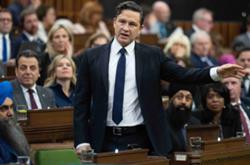Rising inflation has put a significant financial strain on many households.
By October 2023, for example, average consumer prices were more than 15 per cent higher than they were immediately before the COVID-19 pandemic. Essential items such as shelter and food have seen particularly sharp rises — up roughly 20 per cent and 23 per cent respectively over those three years.
At the same time, Canadian governments — federal, provincial and territorial — have increased the stringency of their climate policies. Some people have drawn a connection between these two facts, suggesting that climate policies such as the carbon tax are behind recent affordability challenges.
While concern around affordability is clearly warranted, climate policies are not a significant driver of the rising cost of living. Nor will removing policies such as carbon pricing materially improve the situation.
Before diving into the potential effect of carbon pricing on consumer prices, it’s worth appreciating the scale of Canada’s current affordability challenge.
How costly is the cost of living right now?
Simply put, higher consumer prices effectively reduce real incomes — a lot. From February 2020 to the summer of 2023, the total impact of consumer price increases was akin to a nearly $100-billion drop in aggregate household disposable income. There are also serious equity implications because not everyone experiences inflation in the same way.
Using the latest data from Statistics Canada, we compare the prices of specific products between February 2020 and the summer of 2023.
We estimate that the median family earning less than $30,000 per year faced expenditure pressures due to rising prices since February 2020 equivalent to $395 per month. Families earning between $60,000 and $90,000 annually faced median costs from these increases of around $635 per month. The impact varies based on individual household characteristics, such as the nature of their work, family size and whether they own or rent their homes.
While the rate of inflation has decreased recently, disparities among households persist. Mortgage-free homeowners, for example, have seen a smaller impact on their finances than those with mortgages who were affected by rising interest rates.
So where does climate policy in general, and carbon pricing specifically, fit into this picture?
Climate policies may affect affordability through several channels. We most frequently think of these policies as changing consumption because they can influence the price of transportation, housing, energy and more.
For instance, regulatory measures such as clean fuel standards can increase consumer prices by increasing refineries’ costs of producing transportation fuels to meet those standards — costs that are passed on eventually to the consumer. On the other hand, policies promoting renewable electricity sources can lead to lower electricity prices through lower costs of production.
Overall, climate policies are not a key part of Canada’s recent inflation story.
The small cost of a carbon price
Recent research has clearly established that a significant portion of the increase in inflation stemmed from a global surge in energy prices. Carbon pricing and other indirect tax changes (such as sales and excise taxes) have contributed minimally. We know this because Statistics Canada regularly tracks and reports on price changes that strip out the effect of indirect taxes.
With the latest data, we find that the gradually increasing indirect taxes, including carbon taxes, have caused overall consumer prices to be only 0.6 per cent higher in October 2023 than they were in January 2015.
This indicates that nearly all the overall price increases in 2021 through 2023 are due to other factors. Similarly, recent declines in inflation are primarily due to falling energy prices.
The effect of carbon pricing on rising food prices is even smaller, accounting for the indirect effects of carbon taxes.
For British Columbia, the latest estimates from Statistics Canada suggest carbon taxes increased the average cost of food by about 0.33 per cent relative to what they would be in the absence of carbon taxes. That’s the entire effect. Other necessities such as clothing and footwear are approximately 0.2 per cent more expensive due to the carbon tax.
These are still effects, to be sure, but they are orders of magnitude smaller than the actual increases in prices we’ve seen in Canada. Carbon pricing is definitively not to blame for affordability challenges. (We discuss this in more detail in a recent piece for the University of Calgary’s school of public policy.)
Affordability is not just a matter of prices; income also plays a critical role. Real income, which is income divided by the overall price level, determines the quantity of goods and services one can purchase.
It’s just as crucial to also consider the effect of complementary policies such as low-income rebates or the federal climate action incentive payment to understand any effects of climate policies on affordability.
Payments outweigh the carbon tax cost
Consider the federal backstop system, which levies the federal fuel charge in provinces and territories without a comparable system of their own. The revenues from these taxes fund direct cash transfers, mostly to individuals.
Each year, the federal government rebates roughly 90 per cent of the revenue raised within these jurisdictions to households in lump sum payments through the income tax system (the climate action incentive payment). The amount a family receives depends on its size and location. Payment is automatic and independent of income. All that’s necessary is to file a tax return.
Importantly, most families receive more in rebates than they pay in carbon taxes. Rebates are cash transfers that do not depend on how much fuel any individual or family uses. They depend on family size (single versus couple, and the number of children) as well as location (rural versus urban). People who drive less will receive the same rebate but pay less in carbon taxes.
Using Statistics Canada’s latest data, we estimate that the median annual net cost of carbon taxes for households in Ontario in 2023 was negative, around -$300, meaning that most households received $300 more in rebates than they paid in carbon taxes.
This is in stark contrast to the situation in British Columbia, where a more selective rebate strategy, dependent on income and household size, results in most households paying more in carbon taxes than they receive in rebates. The B.C. government reduced its income tax rates when carbon taxes were originally introduced there, which complicates the comparison.
Support to industry also matters. Recent analysis reveals that indirect costs — where carbon taxes levied on fuel cascade through the supply chain and affect the price of goods and services throughout the economy — are significantly lower due to competitiveness protections provided to large emitters.
In effect, large-emitter carbon pricing systems provide their own kind of “rebate” to firms in the form of subsidies based on how much they produce. The effect is large. Indirect costs are roughly cut in half as a result.
For instance, at a carbon price of $65 per tonne, the analysis finds that the average household in Ontario experiences only a $2 increase in monthly grocery costs. In Alberta, it is $5. Without the large emitter systems, these costs would be $9 and $22 per month higher respectively.
Some people reject estimates such as these as overly narrow and point to a 2022 report by the Parliamentary Budget Office that argues most families are worse off under carbon pricing. These estimates incorporate projected reductions in future economic growth, which lower household real incomes as a result.
We do not dispute this, but other work looking at B.C.’s carbon tax suggests the distribution of real incomes also matters. In B.C., lower-income households have higher real incomes with the combination of the carbon tax and rebates, even when accounting for changes in economic activity.
Importantly, were it not for carbon pricing, Canada would have to adopt other, less efficient policies that would have an even larger drag on growth and therefore larger costs to households — all without the current rebates.
The challenge lies in balancing effective climate policy with equitable affordability concerns. Thoughtful policy design and co-ordination are necessary to ensure that climate policies reduce emissions effectively, while not exacerbating affordability challenges for Canadian households.
Jennifer Winter is the departmental science adviser at Environment and Climate Change Canada, but she did not write this in her capacity as the adviser.
Happy holidays, readers. Our comment threads will be closed until Jan. 2 to give our moderators a much-deserved break. See you in 2024! ![]()
Read more: Energy, Environment















